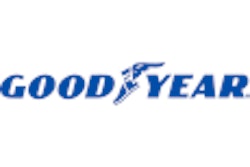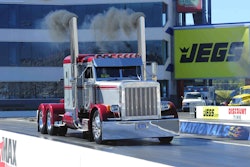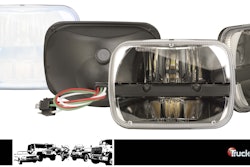COVER STORY
Cascadia quickly earns street cred as an aerodynamic leader on nation’s highways
Freightliner’s Cascadia is such a familiar truck on the road it’s hard to remember what a startling sight it was when introduced in the summer of 2007. The huge grille opening, the sculpted doors, the visorless windshield, the pedestal-mounted mirrors, the stubby side extenders — all of it was new. And all of it was the result of extensive wind tunnel tuning of a finely wrought design.
Scan this QR code or visit htp://truckersnews.com/testdrives to view a photo gallery of this truck. Find a QR reader in device’s app store.
Ever since the introduction of Kenworth’s T600 more than 25 years ago, truck manufacturers have been refining the aerodynamics of the conventional tractor. After all, a wind-cheating design has become critically important in truck design, since at speeds more than 50 mph, the effort in pushing the wind aside is the major contributor to fuel use.
To develop the Cascadia, Daimler Trucks designed and built its own wind tunnel in Portland, Ore. More than 2,500 hours were spent testing, redesigning and retesting using full-size models to create the new truck.
And since its introduction, the Cascadia has been back in the wind tunnel to make it possibly the most aerodynamic truck ever.
The extension of the fender line into the doors is no styling exercise — though it does make the Cascadia distinctive from the side. The flowing lines help manage the airflow along the cab and sleeper. Lately, the visor is back as an option, though it performs a useful function in helping move the air over the rooftop. The side extenders have grown a little to keep the air attached and flowing onto the trailer sides.

And the big grille and the huge 1,625-square-inch radiator still make the Cascadia distinctive since truck grilles have become smaller over the years. But the grille’s function is simple: The big opening draws in as much air as possible to minimize fan-on time. Reducing fan use lowers the corresponding parasitic draw on the engine and the small but significant penalty in fuel used.
Fuel use is also minimized by the engine choices, 13-, 15- and 16-liter Detroits and the Cummins ISX 15, all optimized to run with selective catalytic reduction to meet the 2010 emissions regulations.
Another distinctive feature of the Cascadia is the small windows in the sleeper. They don’t help with fuel economy but they do eliminate the potential water leakage path that is always possible with conventional mounting of glass in rubber.
The test vehicle
The Freightliner here features the Detroit DD15 at 475 horsepower and 1,650 lb.-ft. of torque backed by an Eaton FRO-16210C 10-speed transmission. The 125-inch BBC cab and sleeper are trimmed in vinyl with Mordura cloth for the seats, and up front is a nicely equipped dash. There’s woodgrain on the panel and a grey-on-grey interior to give the cab a luxury feel. Rubber mats are over sound insulation for practicality in the cab. Carpet covers the sleeper floor. Suspension seats are featured on both sides.
A tilt/telescope steering column puts the four-spoke, switch-in-spoke steering wheel where the driver feels most comfortable and connects to a TRW THP-60 steering gear.
The sleeper is the standard 72-inch-high roof Cascadia, and it has 94 inches of standing room, a 30-inch upper and 40-inch lower bunk.
Underneath all, this Cascadia has axles by its own newly renamed Detroit division. These corporate axles are shared with other Daimler products worldwide, with the DA-F steer axle on Freightliner’s taper-leaf springs and the DA-RT drive tandem on an Airliner 40,000 air suspension. The axle ratio is a 3.42-to-1 (see “Powertrain Detail” on this page). Wheel ends are by ConMet and all-round drum brakes are by Meritor.
To meet the latest FMVSS 121 braking distance requirement, these are big brakes with 16.5-by-5 Q Plus up front and 16.5-by-8.62 Q Plus on the tandem. Since they are necessarily big to generate the required braking torque, they feature massive amounts of friction material so will likely not require any service for awhile.
The Accuride wheels carry premium tires: Goodyear G399 295/75R22.5 up front and G572 on the drives. These are Goodyear’s Fuel Max tires to meet California Air Resources Board economy requirements.
Also meeting CARB mandates is a clean-idle sticker on the side of the hood. But for those cool winter nights, a toasty Webasto AirTop heater is provided under the bunk.
On the road
The Cascadia came from Los Angeles Freightliner in Fontana, Calif. The dealership is on Valley Boulevard, which has to be one of the worst pieces of pavement anywhere. So the first surprise was the comfortable ride of the Cascadia even as it bobtailed to pick up a new Utility reefer. Other trucks can bang and crash over this road, but the Cascadia was remarkably smooth.
We picked up Interstate 10 westbound and then I-15 to the high desert. Again, the ride of the Cascadia impressed, coping with the rough concrete of this stretch of interstate admirably.
The other impressive feature was the lack of noise. Admittedly we were treading lightly on the surface streets, but there was no cab-created noise, no booming or rattling. Once on the freeway, the truck settled into a quiet cruise, showing an excellent 63 decibels, which is comparable with — or even a shade quieter than — some of its closest competitors.
Another excellent feature was the sporty shifter Freightliner has engineered for the 10-speed. It had a close gate with short throws, but it was not in the least heavy. It made life very easy, and the good throttle modulation meant little difficulty with the gears, whether clutching or float-shifting the transmission.
As with all modern truck diesels, the DD15 has excellent clutch engagement torque and needs no throttle to get the truck moving. Then almost no foot-feed is necessary to get to speed. Going through low range, 900 rpm was all that was needed. Flicking the range-change up and pulling the shift lever left and back to pick up high range, it was still not necessary to use more than 1,400 rpm to get up to freeway speed, despite this being only a 10-speed.
There are two turbos on the DD15. This is common on an American big-bore diesel where series turbocharging has become almost commonplace. The difference with the Detroit DD15, though, is that the downstream turbo provides power to the flywheel through a reduction gear. The upstream turbo provides the air for the engine by way of a charge cooler. Since the downstream turbo-compound power requires its own backpressure, the engine turbocharger needs no complex variable geometry to recirculate the exhaust. And make no mistake, even though SCR is used to scrub nitrogen oxide from the exhaust, there is still need for some exhaust gas recirculation to meet emissions requirements.
The contribution of the turbo-compounding makes an additional peak 50 hp available and the result is a real kick in the pants when you press down on the accelerator: the DD15 builds torque far faster than any comparable big diesel. So while on paper this is a 475, it feels more like a 550 or 600 as you initially mash the throttle.
This also makes the DD15 a good engine for those little jump-ups such as freeway overpasses that can pull down speed as you get in to them. With the Detroit, the response is immediate and speed is maintained.
Driver comfort
The ride and quiet of the Cascadia help relax the driver, and the multi-adjustable suspension seats make a major contribution. A three-compartment cushion provides excellent lumbar support. The cab width allows for bigger seats: two inches wider, longer and taller. Yet even with the wide seats, there’s 24 inches of walk-through to the sleeper.
And the seats are on swivels so they can double as armchairs when logging off-duty sleeper time.
The view from the driver’s seat is excellent with very little intrusion by the big hood. The view to the rear is displayed in the big mirrors mounted so firmly on the doors you can actually swing on them. The result is a completely vibration-free image. The test Cascadia also featured optional forward-mounted mirrors on the side of the hood, equally firmly mounted and showing an excellent view of the blind spots usually created with a full-width cab. The downward-looking mirror on the passenger door makes assurance doubly sure.
The wood-grain dash features a full complement of gauges including the combination fuel and diesel-exhaust-fluid gauge. It has green LEDs to indicate how much DEF is in the 23-gallon tank. And the fill for the tank is conveniently located behind a flip-open door in the top step on the driver’s side.
On the wing dash is a fuel economy gauge, a useful accessory for any driver. Over there, too, are additional HVAC vents to complement those directly ahead of the driver for good ventilation and cooling.
Back in the sleeper, doors cover the storage closets for a clean look, with openings for the TV and the provision for a Sharp microwave and 120-volt outlets are on both sides in these spaces. They are hooked in to the shorepower receptacle, but likely an inverter could be specified. A Dometic refrigerator is mid-mounted on the passenger side. To the other side, there’s a step to assist in getting in to the upper bunk that folds up flat to the back wall. The lower bunk lifts to reveal the central storage bay and two baggage compartments that are also accessible through outside baggage doors.
The sleeper is set up with good ventilation. Even without the side windows, the top windows crank open and the side panels are equipped with screened vents.
This Cascadia lacks the available wood trim on the cabinets to complement the dash, but even without, the sleeper is a comfortable and practical living space.
Operations
The bumper is in three pieces — as is the hood — for quick and inexpensive repair. For the same reason, the huge windshield is a two-piece roped-in design, allowing for easy and inexpensive replacement. The aluminum cab is designed to withstand not just the ECE 29 crash test but also the far more rigorous Swedish cab test requirements.
Quick-replace items include headlamp bulbs, low-maintenance heating and ventilation system and easy engine access through removable panels.
Summary
The Cascadia is all about size. It is wide and tall inside and a comfortable truck whether driving or resting. The ride is excellent and the lack of noise, whether from the engine or from the road, is impressive.
Despite its relatively recent introduction, the Cascadia has reached an unassailable popularity on America’s highways. They’re so familiar you hardly ever think of the innovation that was introduced back in 2007. But it’s there, working in the background to make the Cascadia a reliable, durable and economical truck.
Powertrain detail
The Detroit DD15 was introduced late in 2007 to power the new Cascadia and Western Star trucks in North America.
The DD15 is an inline six cylinder featuring a common rail fuel system and turbo-compounded output that contributes up to 50 horsepower to the engine flywheel from waste heat in the exhaust stream. The turbo-compounding turbine has an inlet nozzle that converts the heat and pressure in the exhaust gas leaving the turbo to useful energy, while at the same time generating the backpressure needed for the EGR system to work. It drives the flywheel through gears and a fluid-filled clutch or coupling. In this way, it recovers energy normally wasted in a variable-geometry turbo system.
The DD15 covers power from 455-560 hp at 1,800 rpm. Torque ratings are 1,550-1,850 lb.-ft. at a nominal 1,100 rpm, with several multi-torque models offering 450 hp-1,550/1,750 lb.-ft. and 475 hp-1,650/1,850 lb.-ft. ratings.
The DD15 is recognized for its quiet operation. This is a consequence of the multi-event injection via the amplified common rail system, but it is also a result of less radiated combustion noise due to the rigid design on the cast iron block and the compacted graphite iron (CGI) one-piece head with its 38 clamping bolts.
The common rail is fed by a two-stage pump that is fully lubricated by the fuel. In its first compression, pressure rises to 900 bar before the secondary filtration. It then is raised to rail pressure of 2,100 bar. This pressure is amplified nearly four times inside each injector with a double-headed piston eliminating the need for external lines carrying extreme fuel pressures. Each electronically controlled fuel injection event has multiple pulses for precise control of fuel rate and shape, giving fine control of combustion and NOx generation.
In this application, the DD15 drives through an Eaton Solo clutch to a Fuller twin-countershaft FRO-16210C 10-speed transmission. The FR is a recently introduced transmission range offering a weight savings of 32 pounds over the RT series. The C ratio set has the broader gear spread for an overall reduction of 17.17-to-1. This transmission is an overdrive with a top gear ratio of 0.74-to-1.
The rear axle ratio is 3.42-to-1 and with the Goodyear G572 295/75R 22.5 drive tires turning 508 revolutions per mile, the theoretical engine speed is 1,286 rpm at 60 mph. Using the dashboard gauges, the truck appeared to be going around 1,260 rpm at 60 mph. That would be around 1,365 at 65 mph which is an excellent compromise between tall gearing for economy and a useful torque rise back to the engine’s peak torque at 1,100 rpm.
Freightliner Cascadia Specifications
Frame: Freightliner 11/32 inches thick by 3-1/2 inches by 10-3/16 inches steel, 120 ksi
Engine: Detroit DD15, 475 hp, 1,650 lb.-ft. torque
Engine Brake: Jacobs
Transmission: Eaton Fuller FRO16210C, 10-speed o/d
Wheelbase: 225 inches
Front axle: Detroit DA-F 12,000-pound dual taper-leaf suspension
Front tires: Goodyear G399 LHS 295/75R22.5
Rear axle: Detroit DA-RT-40 40,000-pounds, 3.42-1 ratio
Suspension: Freightliner Airliner 40,000-pound air-ride
Rear tires: Goodyear G572 LHD 295/75R22.5
Wheels: Accuride hub pilot, outside polished
Fuel tanks: Dual 120 gallons unpolished
DEF tank: 23 gallons
Fifth wheel: Holland FWS1
Seats: Freightliner Premium on swivels
Interior: Gray vinyl, premium lighting
Other: Freightliner heated, motorized mirrors; hood mirrors; roof fairing, skirts, side extenders; exterior sun visor; remote keyless entry; AM/FM/CD weatherband radio w/ iPod interface; automatic temperature control HVAC; daytime running lights; 160-amp alternator; Borg Warner on/off fan clutch; Delco 69MT starter; Davco 482 fuel/water separator; ConMet pre-set aluminum hubs; Virtual Technician diagnostics.












